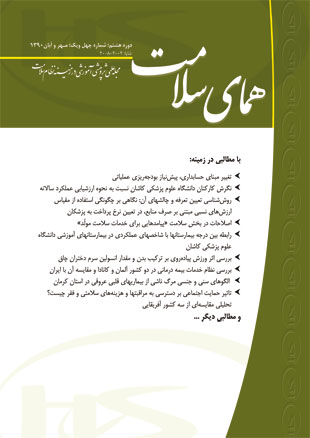فهرست مطالب

دو ماهنامه همای سلامت
سال هفتم شماره 3 (پیاپی 36، امرداد و شهریور 1389)
- 46 صفحه،
- تاریخ انتشار: 1390/02/10
- تعداد عناوین: 9
-
صفحه 4
- خبرها
-
صفحه 5
- مقاله
- آموزه
-
صفحه 32
- ترجمه
-
Page 6Provide an accurate and timely health care service is the symptom of social justice. Preparing a healthy community is an important task that is distinct from the other organizations services due to the nature and urgency. Hence, good performance and optimal health system activity is important for creating a healthy society. In different countries, rapid increasing and rising health care costs has caused healtheconomics experts search for finding new ways to limit health costs that they can allowing a fair distribution of resources and also they can provided services for applicants.This study has aimed to calculate selected global surgeries and comparison with accepted fee in Amin hospital in Esfahan city in 1385.This was a retrospective and descriptive study. Samples were selected during a month in hospital and data collection tool was a checklist made by researcher.After calculating the total cost of selected global surgeries results were compared with accepted fee and differences were determined. Results show that in global payment method, assurance company will lose.
-
Page 10Self-assessment is a framework for the evaluation of organizations in all fields. This tool moves the organization toward excellence. So, Continuous improvement obviously is shown in organizations that have used the self-assessment.This research is a literature review article, based on library studies. This article shows the benefits of self-assessment, implementation process and its techniques. Also this paper will express Baldrige model. Considering Baldrige criteria presented in health careorganizations separately and in order to the scope of this model in different countries, and continuous improvement possibility of model. It seems that this model is useful for health care organizations, particularly in hospitals.
-
Page 17The excess costs are the cases where the hospital managers should take note them and must be control and remove. This study has done to determine the cost of surplus sheets printing in Al-Zahra hospital. This is a cross sectional and applied researchwith descriptive and analytical results. In this study, we specified the type and cost of used paper and ink (or cartridge) from central warehouse. Then we specified thecharacteristics of hospital printers (in different units) and determined their annual service and repair costs with hospital computer management center data.In spring of 1385 difference between total printing costs and costs of surplus sheets printing in hospital was calculated 50,298,050 Rials. This study says that removing (or control) the surplus printers and repairing the hospital computer network; and also use from CD or diskette for data archives and sending the data and information arethe cost reducing way and it is possible.
-
Page 22In last decade; important changes has done in the public and private services by health system and also health organizations integrate some of services in developing countries. Partnership in public and private health sectors can help government agencies for delivermore cost –effective services to population. In developing countries governments says they have difficulties in presenting the basic service for target population. They rely to contract with private sector (profit and nonprofit organizations) as a strategy to meet theneeds of populations. For improve the quality of care and increasing the access to services and also increase of availability of medicines and medical supplies, Contract with the private sector have selected to presenting the primary healthcare by thegovernmental sector. Private sector has served in both urban and rural fields for the rich and the poor population. Communities often recognize that private sector is more responsive to their healthcare needs and preferences in terms of services available, suitable time or geographical access.
-
Page 27Suicide in the year 2000 has been the 25th leading cause of death in the WHO Eastern Mediterranean Region and therefore, it could not be considered as one the most urgent health problems. However, different age and sex groups in this region have demonstrateddifferent patterns of suicide, which worthy of consideration. This study uses data based on the ICD9 codes E950-E959 (suicides), which have been provided by the WHO Global Burden of Disease project for 2000, version 1. Different age and sex groups (5-14, 15-29, 30-44, 45-59, 60 and above) standardized rates of suicidal deaths based on the countries’ level of income were plotted and compared with each other. Similar procedure was applied to compare suicide deaths as a proportion of all deaths due to injury.The results show that in the first and the second age groups the rates of suicide are higher in females in comparison to males. For the rest of the age groups the rates of suicide are higher in males in comparison to females. The most high-risk age group amongfemales is the second one (8.6 per 100000) and among males is the last one (10.8 per 100000). Furthermore, plotting suicide deaths as a proportion of all deaths due to injury reveals that in all age groups especially the second one the proportion of such deaths issubstantially higher in females in comparison to males.In the WHO Eastern Mediterranean Region females in the age group 15-29 and males in age group 60 and above are among the most high-risk people in terms of committing suicide. Therefore, more attention should be paid to the ways of preventing suicideamong on these age groups especially in the countries with low and middle income.


